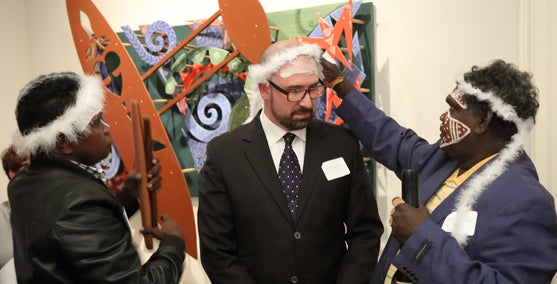In layers of artistic complexity, Henry Skerritt finds depth and meaning

Immediately after Henry Skerritt defended his thesis for his PhD from the Dietrich School’s Department of History of Art and Architecture (HAA), he was on the road to the University of Virginia. There was no time to celebrate; the following day, he was scheduled to oversee the launch of an exhibit.
Still, Skerritt reflected on the deep sense of satisfaction he’d felt during his defense: the rich comments from the faculty who had mentored him since he moved to the United States in 2011 to study under Terry Smith, the Andrew W. Mellon Professor of Contemporary Art History and Theory.
Much has happened to Skerritt since that move, including the birth of his two children and earning a second master’s degree from HAA (he already had one from the University of Melbourne in Australia). In the fall of 2016, he was named the Mellon Curator of Indigenous Arts of Australia at Virginia’s Kluge-Ruhe Aboriginal Art Collection. It is the largest collection of Aboriginal art outside of Skerritt’s native Australia, and as its curator, he senses a purpose for which he has spent years training.
“I feel a bit more of a mission here to get this work out,” he says, adding that in Australia, the art of its indigenous people is already well known and well respected. In the United States, the work is less famous. But he’s planning to change that.
“I sense it’s one of the most historic things that I’ll ever do, but I’m not doing it. It’s really about creating a space” for the artists to tell their own stories, he says.
After earning his undergraduate degree and his first master’s, Skerritt was working in a commercial gallery specializing in Aboriginal Australian art, which is where he first began meeting some of the artists. He was impressed by the sophistication and confidence of their art, which far surpassed those of their contemporaries. Despite their completely different cultural background, Aboriginal artists were complex and engaged in a new level of conversation with the world.
“For me, it was a kind of epiphany that here on our doorstep in Australia, we had one of the world’s most incredible contemporary art movements,” says Skerritt.
“Aboriginal art is all about dialogue. It’s about sharing your culture with the world.”
The lesson of Aboriginal art, he says, is that the world has hidden layers of depth and meaning.
“You’re never going to 100 percent know another person. You know the outside parts,” is one way Skerritt summarizes the message.
During a one-year stint at the University of Melbourne’s Ian Potter Museum of Art, where he was curating an exhibition through a fellowship, the museum’s director urged him to consider going to the University of Pittsburgh to study under Smith.
“That was, obviously, a very big step,” recalls Skerritt. He hadn’t thought about going to America, but Smith had been a significant influence on him, so he applied and feels “really lucky” to have been accepted.
“I haven’t looked back. Coming to Pitt was really an amazing journey,” Skerritt says.
He is particularly grateful for the rigor of the program, believing it accords Aboriginal art its due as one of the great contemporary movements. He also appreciated the high value the program places on teaching.
“It was instilled in us that teaching was not a peripheral part of what we did; it was a core part of our academic mission,” he says. He learned how to give students high-stakes challenges that pushed them, a skill set he’s taken to the University of Virginia.
Skerritt also drew inspiration from the fact that HAA emphasizes teaching a diverse range of arts.
“I came out quite emboldened by that experience, where being a scholar meant being globally aware,” he says. “I think that’s something that Pitt in general values a lot.”
In graduate school, HAA students were taught to think of themselves as mentors to undergraduates, much as they themselves were mentored by faculty. Skerritt believes that approach and sense of community does color his approach to working with undergraduates, whom he teaches in a seminar about the history of Aboriginal art.
Though he had to miss the formal commencement on Pitt’s campus after his dissertation, Skerritt did unexpectedly mark the occasion the following day, when he was introducing the artists for the exhibition that launched in Virginia. As his wife and their two children looked on, artists Yinimala Gumana and Wukun Wanambi emerged in paint and ceremonial regalia, complete with a didgeridoo – the ancient wind instrument of indigenous Australians.
They spoke with eloquence and power of their art and culture, then called Skerritt and his family forward and announced that they were giving him his graduation ceremony. They decorated his forehead with a streak of ochre and placed a feathered headdress on his head, then performed a song.
For Skerritt, there could have been no more perfect culmination to his journey.
“It beats hood and gown any day,” he says. “I was so honored, and so touched.”
